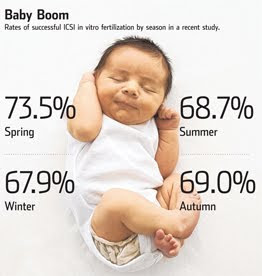Season With the Best Odds for IVF

Infertile couples undergoing in vitro fertilization might have more success if the procedure is performed in the spring.
Research published in July's Gynecological Endocrinology found the rate of fertilization was significantly higher in spring than any other season, though time of year had no effect on pregnancy rates. Natural reproduction also varies with the seasons; it is believed the number of hours of sunlight in the day and temperature variations affect fertility.
Researchers compared seasonal fertilization rates in 1,932 women who underwent intracytoplasmic sperm injection, or ICSI, in Brazil from 2005 to 2009. ICSI involves the injection of a single sperm directly into an oocyte, or unfertilized egg, outside of a woman's body.
Subjects were organized into groups according to the timing of oocyte retrieval: 435 were assigned to winter, 444 to spring, 469 to summer and 584 to autumn. Fertilization, the fusion of sperm and egg to form an embryo, was assessed 18 hours after ICSI.
The rate of fertilization was 73.5% in spring, 68.7% in summer, 67.9% in winter and 69% in autumn. Ovarian response to ICSI hormone treatments, a measurement of estrogen concentration per number of retrieved oocytes, was higher in spring compared with other seasons, tests showed. Following fertilization, one to three embryos were transferred into the woman's uterus.
The procedure resulted in an average pregnancy rate of 33% for all seasons.
Study: Seasonal variability in the fertilization rate of women undergoing assisted reproduction treatments
Source
Photo credit: wsj.com
All rights reserved
TODAY'S BOOK SUGGESTION:

( Assisted Reproductive Technology )
by Geoffrey Sher, Virginia Marriage Davis, Jean Stoess
-- This clearly written technical handbook guides couples who are trying to conceive in determining whether they are eligible for in vitro fertilization (IVF) and in selecting the program that will help them achieve the best results.
It describes in detail the anatomy and physiology of conception and the steps required for realizing it in the IVF procedure.
In addition to providing accurate information, the practitioner authors address emotional, financial, physical, and moral-religious issues involved in the decision to conceive with medical assistance.
Despite its experimental reputation and persistent high cost, IVF is an appropriate option for many of the estimated 3.3 million infertile couples in the U.S. today, so this specialized manual speaks to a rather large audience of potential users.
Click to order/for more info: In Vitro Fertilization
Category: embryo transfer, Fertility, ICSI, In vitro fertilisation, In vitro fertilization, IVF









0 comments